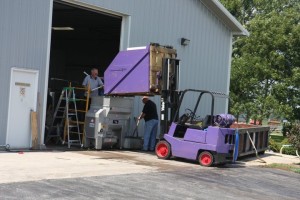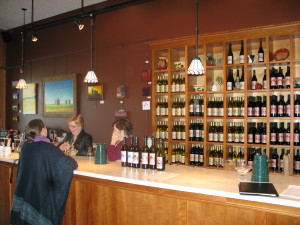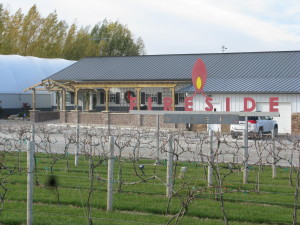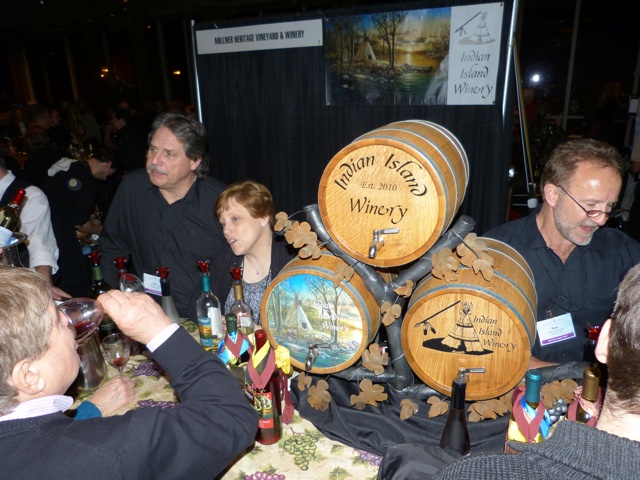I80 Wine Tour Through Illinois, Iowa and Nebraska
This article is the second installment of a two-part article about wine tourism along Interstate 80 in the Midwest. In the first article, we visited Ohio and Indiana. Now join us on a winery trip along I80 through Illinois, Iowa and Nebraska.
Illinois

“Ritt” the owner of Lavender Crest Winery, who recently celebrated his 91st birthday, prefers his fork lifts purple.
Traveling west from Indiana, I80 runs for 175 miles across Northern Illinois, crossing the Mississippi River in Rock Island, Illinois. This part of Illinois includes two loops of the state’s Northern Illinois Wine Trail — the Northwest Loop with Lavender Crest and Creekside Vineyard Wineries and the south end of the Fox River Valley Loop, which includes Illinois River Winery in Utica.
Illinois River Winery makes almost all its wine from Illinois grapes. The Winery’s Cabernet Franc and Norton wine are made from Southern Illinois grapes. Illinois River’s semi-sweet Riesling is made from grapes grown on bluffs along the Illinois River, which parallels I80 for 60 miles.
Illinois River Winery has a popular tasting room in Utica, a few miles south of I80. Also in Utica is the August Hill tasting room, home of the award-winning Illinois Sparkling line up. Utica is just across the Illinois River from the most popular state park in Illinois, Starved Rock State Park, with its scenic canyons and waterfalls.
“I80 represents the border between extremely cold-hardy and cold-hardy grapes,” says Bradley Beam, enology specialist with the Illinois Grape Growers and Vintners Association. To the south, Seyval Blanc, Chambourcin and some Norton are popular cultivars. To the North, typical wine grapes include Frontenac, La Crescent, and Marquette varieties which were all developed at the University of Minnesota.
But it’s difficult to choose a signature grape or wine, Beam says. ‘We grow so many grape varieties here, about 40 different kinds, and they can be made into a variety of different wines” he notes. ‘The most commonly grown white wine grape for the entire state is Vignoles,” Beam says. “Chambourcin would be the most popular red, but Frontenac is up there too,” he adds.
The biggest problem for Illinois grape growers is a familiar one — selecting the right variety for the site. ‘Several of the cold hardy varieties are prone to early bud break,” Beam says, but that can be partially overcome by planting at higher elevations. (Cold air is heavy and sinks into low-lying areas.)
Wines made here are both pure varietals and blends. Creekside Winery, with its wine terrace just off I80 near Moline, makes Marechal Foch, La Crescent, La Crosse and Traminette, all from Illinois grapes. Lavender Crest, also near Moline, produces a spicy, oak aged Chambourcin and a Frontenac/Merlot blend with an unusual, eccentric character. (The Frontenac is grown locally, but the Merlot is imported.)
‘We’ve been fortunate to see so many new varieties,” Beam adds, noting that the new University of Minnesota and Cornell Universtity varieties, like Traminette, seem to hold the most promise. ‘Marquette is doing quite well north of I-80, and several of the Cornell varieties are catching on further south.”
Iowa
In Iowa, it’s easy to tour wineries along I80. That’s because the I80 Iowa Wine Trail has nine wineries within 10 miles of the interstate including Wide River Winery in Le Clair, Brick Arch Winery in West Branch and Jasper Winery in Des Moines.
A variety of grapes grow along the I-80 corridor, including whites like Brianna, LaCrescent, Frontenac Gris and LaCrosse as well as reds like St. Croix, Chancellor, Norton and Marquette. Michael White, viticulture specialist for Iowa State University’s extension program says if he had to name a signature grape, it would be Edelweiss for white and Marechal Foch or Frontenac for red.
‘Frontenac is easy to grow here,” he says. “Most growers wait until the Brix (sugar level) is over 26% to harvest,” according to White. (Frontenac is one very sweet grape. For comparison, the Thompson Seedless grapes in the grocery store are about 20% sugar.)
LaCrescent is also popular with winemakers and wine drinkers, but it can be hard to grow, says White. If you can find an Iowa LaCrescent, consider tasting it immediately. Wineries often run out out of LaCrescent between harvests.
Growing grapes in Iowa requires specials skills. Fortunately, Iowa farmers are some of the most productive in the world. In Iowa, heavy rainfall and high humidity can be a challenge. Iowa’s fertile soils create another issue. ‘Too much vigor can actually be a problem with wine grapes,” says Smith. “You want your vines to struggle a little.”
Some of the vigor is tamed by allowing grass in the vineyards to grow right up to the vines rather than keeping it confined to narrow strips.
Allowing more space between vine rows has also helped grape quality. ‘When we started our vineyards, we followed the Missouri rule of planting vines six to eight feet apart. It turns out, ten to 12 feet spacing is better for us,” Smith says. The only other issue for Iowa grapes is the soil’s high potassium level, which means it’s essential for Iowa wine-makers to cold stabilize their wines to avoid the formation of potassium bitartrate crystals. (If you’re unsure about these terms, the winemakers of Iowa will be glad to explain them to you during your visit.)
Iowa State University has a research vineyard that’s currently testing Cornell varieties like Corot Noir, Arandell and Aromella. ‘These Cornell grapes are grown primarily in the lower two-thirds of Iowa,” says Smith,
But Smith says he has a couple of new varieties he reports are coming on strong. ‘Frontenac Blanc is great, it will rival La Crescent in a few years,” he says, ‘And if you can get your hands on it, Petite Pearl is another hybrid that shows promise.”
Nebraska
Once I-80 leaves Iowa, it swings into Omaha, then on to Lincoln. After Lincoln, the I-80 follows a nearly-straight line for 72 miles as it travels through the valleys of the South Platte and Platte Rivers. The soil in the river valleys is sandy and well drained, perfect for growing grapes.
‘We started in 1994, so it’s a new industry for us,” says Jennifer Montgomery, the first full-time executive director of the Nebraska Winery and Grape Growers Association. But the Nebraska wine industry has a long history. In 1910, Nebraska had close to 5,000 acres of grapes planted in the state’s 11 eastern counties. Still, the first post-Prohibition winery in the state, Cuthills Vineyards in Pierce, didn’t open its doors until 1994. Ed Swanson at Cuthills was instrumental in determining what wine grapes will grow in Nebraska and is considered the father of Nebraska viticulture.
The Nebraska wine industry has grown substantially over the past decade. Now, there are nearly 30 wineries and tasting rooms, and most are within access of I80.
‘Our population is centered in the eastern part of the state,” says Montgomery, “so it makes sense that many of the wineries are located close to Lincoln and Omaha. Deer Springs Winery, for example, is located minutes from Lincoln, as is the James Arthur Vineyard, the state’s largest and one of its oldest wineries.”
Soaring Wings Vineyard is in Springfield, just south of Omaha. Cellar 426 Wines & Vines lies between Soaring Wings and Deer Springs Wineries. Also nearby is Glacial Till Vineyard and Winery. Further west, toward Grand Island, you’ll find Prairie Creek Vineyards and Miletta Vista Winery. Feather River Vineyards lies southwest of North Platte, Nebraska, and 17 Ranch Winery in Lewelle is the last winery you’ll pass (for now) before heading out-of-state.
‘I wouldn’t say we have a signature grape,” says Montgomery. ‘But our soil and topography are excellent for the Edelweiss grape. And for red, it’s probably Frontenac because wine-makers can do so many different things with it, including making a rose and a port wine.”
Paul Read, professor of viticulture at the University of Nebraska Lincoln, has been testing grapes at the University’s research vineyards since 1997, and he agrees that Edelweiss is Nebraska’s white-grape winner.
‘James Arthur Vineyard just crushed 92 tons of Edelweiss. That’s going to make a lot of Edelweiss wine” Read says. That kind of quantity, in fact, is enough to make some wineries question if more Edelweiss is needed.
Read tells of a winery owner who, several years ago, said he didn’t want to make Edelweiss because the market was flooded with it. But when Nebraska Edelweiss wins awards, customers ask for it, he says.
Other promising whites in Nebraska are Vignoles and Brianna, a strong grower in Nebraska. Both grapes can be made into different styles of wine which adds to their appeal.
As for a signature red, Read says ‘We’re still looking for it.” Frontenac is a reliable grape, he says — it grows well, although its high acidity becomes a problem for wine-makers. Like Iowa, growers typically wait for a 26 Brix level to harvest Frontenac.”
Marechal Foch is another ‘safe bet” red, says Read. ‘It doesn’t make bad wines, but we’re looking for that red that will make a really good wine.”
Soaring Wings Vineyard produces a quality Norton, says Read, but Norton struggles in the colder parts of the state. The ‘up-and-comer” red that looks most promising at present is Marquette, a hybrid from the Minnesota program. ‘I’d say it has the most potential,” says Read. Another possibility for a signature red wine is Petite Pearl, Read says.
Whatever eventually emerges as Nebraska’s ‘signature red” there is no question that Nebraska is making huge strides in the wine industry.
‘Next spring,” says Montgomery, ‘we’ll hold our first Statewide Wine Festival.” The festival is a sure sign that the Nebraska wine industry is growing stronger every year.
No matter where I80 may take you — or at least through the five states mentioned here — you’ll no doubt find wines you’ll enjoy. Why not get off the highway and sample some of these ‘signature” Midwest wines for yourself?
Homepage photo Miletta Vista Winery in St. Paul Nebraska






This article is riddled with careless geographic errors. The author should have more consideration for the readers.
Such as?
This article really should include Mac’s Creek Winery & Vineyards in Lexington. A leader in Nebraska wines and viticulture.